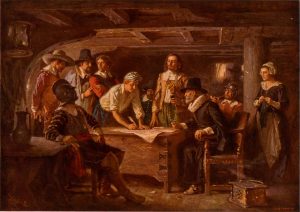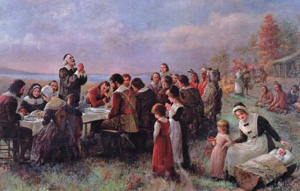 In September 1620, a small ship called the Mayflower left Plymouth, England, carrying 102 passengers—50 men, 19 women and 33 young adults and children. Just 41 were true Pilgrims, religious separatists seeking freedom from the Church of England. The others were considered common folk and included merchants, craftsmen, indentured servants and orphaned children—the Pilgrims called them “strangers.”
In September 1620, a small ship called the Mayflower left Plymouth, England, carrying 102 passengers—50 men, 19 women and 33 young adults and children. Just 41 were true Pilgrims, religious separatists seeking freedom from the Church of England. The others were considered common folk and included merchants, craftsmen, indentured servants and orphaned children—the Pilgrims called them “strangers.”
Seeking the right to worship as they wished, the Pilgrims had signed a contract with the Virginia Company to settle on land near the Hudson River, which was then part of northern Virginia. The Virginia Company was a trading company chartered by King James I with the goal of colonizing parts of the eastern coast of the New World. London stockholders financed the Pilgrim’s voyage with the understanding they’d be repaid in profits from the new settlement.
Storms threw them off their course and instead of reaching the Virginia Colony, they landed in Provincetown Harbor in November, 1620 after a treacherous and uncomfortable crossing that lasted 66 days. When the Mayflower landed in Massachusetts instead of Virginia, discord began before the colonists even left the ship. The strangers argued the Virginia Company contract was void. They felt since the Mayflower had landed outside of Virginia Company territory, they were no longer bound to the company’s charter.
The defiant strangers refused to recognize any rules since there was no official government over them. Pilgrim leader William Bradford later wrote, “several strangers made discontented and mutinous speeches.”
Pilgrim leaders wanted to quell the rebellion before it took hold. After all, establishing a New World colony would be difficult enough without dissent in the ranks. The Pilgrims knew they needed as many productive, law-abiding souls as possible to make the colony successful. With that in mind, they set out to create a temporary set of laws for ruling themselves as per majority agreement.
While on board the Mayflower in Provincetown Harbor, the Pilgrims drew up the Mayflower Compact and all the men aboard the ship— 41 adult male colonists, including two indentured servants—signed the Mayflower Compact on November 11, 1620 (although it wasn’t called that at the time).
This document created the way for the Pilgrims to govern themselves. The Mayflower Compact was important because it was the first document to establish self-government in the New World. It remained active until 1691 when Plymouth Colony became part of Massachusetts Bay Colony.
After exploring the area, the Pilgrims decided to settle in Plymouth.
Throughout that first brutal winter, most of the colonists remained on board the ship, where they suffered from exposure, scurvy and outbreaks of contagious disease. Only half of the Mayflower’s original passengers and crew lived to see their first New England spring. In March, the remaining settlers moved ashore, where they received an astonishing visit from an Abenaki Indian who greeted them in English. Several days later, he returned with another Native American, Squanto, a member of the Pawtuxet tribe who had been kidnapped by an English sea captain and sold into slavery before escaping to London and returning to his homeland on an exploratory expedition. Squanto taught the Pilgrims, weakened by malnutrition and illness, how to cultivate corn, extract sap from maple trees, catch fish in the rivers and avoid poisonous plants. He also helped the settlers forge an alliance with the Wampanoag, a local tribe living on Cape Cod, Nantucket, Martha’s Vineyard, and inland. Massasoit was the chief. (“Massasoit” in the Wampanoag language means “great leader” and “Wampanoag” means “People of the Dawn”.) In early spring of 1621, the Pilgrims met with Massasoit and agreed to live peaceably with the Wampanoags and to help each other. This relationship would endure for more than 50 years and tragically remains one of the sole examples of harmony between European colonists and Native Americans.
Thanksgiving at Plymouth

In the spring, with help from the Indians, the Pilgrims planted corn (maize), peas, and barley. They also hunted fowl and deer, searched for wild berries and fruits, and fished. In late fall after the corn harvest, the Pilgrims gave thanks by celebrating the first Thanksgiving feast with the Indians.
In November 1621, after the Pilgrims’ first corn harvest proved successful, Governor William Bradford organized a celebratory feast and invited a group of the fledgling colony’s Native American allies, including the Wampanoag chief Massasoit. Now remembered as American’s “first Thanksgiving”—although the Pilgrims themselves may not have used the term at the time—the festival lasted for three days. While no record exists of the historic banquet’s exact menu, the Pilgrim chronicler Edward Winslow wrote in his journal that: Our harvest being gotten in, our governor sent four men on fowling, that so we might after a special manner rejoice together, after we had gathered the fruits of our labors; they four in one day killed as much fowl, as with a little help beside, served the Company almost a week, at which time amongst other Recreations, we exercised our Arms, many of the Indians coming amongst us, and amongst the rest their greatest king Massasoit, with some ninety men, whom for three days we entertained and feasted, and they went out and killed five Deer, which they brought to the Plantation and bestowed on our Governor, and upon the Captain and others. And although it be not always so plentiful, as it was at this time with us, yet by the goodness of God, we are so far from want, that we often wish you partakers of our plenty.
When they ate, the Pilgrims did not use forks. They used a knife, spoon, a large napkin, and fingers. They also shared plates and drinking vessels. The Pilgrims did not eat cranberry sauce and pumpkin pie at the first Thanksgiving. They ate roasted wild fowl such as duck, goose, and turkey, cornmeal, cod, sea bass, and venison brought by the Indians. Historians have suggested that many of the dishes were likely prepared using traditional Native American spices and cooking methods. Because the Pilgrims had no oven and the Mayflower’s sugar supply had dwindled by the fall of 1621, the meal did not feature pies, cakes or other desserts, which have become a hallmark of contemporary celebrations.
Thanksgiving Becomes an Official Holiday
Pilgrims held their second Thanksgiving celebration in 1623 to mark the end of a long drought that had threatened the year’s harvest and prompted Governor Bradford to call for a religious fast. Days of fasting and thanksgiving on an annual or occasional basis became common practice in other New England settlements as well.
During the American Revolution, the Continental Congress designated one or more days of thanksgiving a year, and in 1789 George Washington issued the first Thanksgiving proclamation by the national government of the United States; in it, he called upon Americans to express their gratitude for the happy conclusion to the country’s war of independence and the successful ratification of the U.S. Constitution. His successors John Adams and James Madison also designated days of thanks during their presidencies.
In 1817, New York became the first of several states to officially adopt an annual Thanksgiving holiday; each celebrated it on a different day, however, and the American South remained largely unfamiliar with the tradition.
In 1827, the noted magazine editor and prolific writer Sarah Josepha Hale—author, among countless other things, of the nursery rhyme “Mary Had a Little Lamb”—launched a campaign to establish Thanksgiving as a national holiday. For 36 years, she published numerous editorials and sent scores of letters to governors, senators, presidents and other politicians.
Abraham Lincoln finally heeded her request in 1863, at the height of the Civil War, in a proclamation entreating all Americans to ask God to “commend to his tender care all those who have become widows, orphans, mourners or sufferers in the lamentable civil strife” and to “heal the wounds of the nation.” He scheduled Thanksgiving for the final Thursday in November, and it was celebrated on that day every year until 1939, when Franklin D. Roosevelt moved the holiday up a week in an attempt to spur retail sales during the Great Depression. Roosevelt’s plan, known derisively as Franksgiving, was met with passionate opposition, and in 1941 the president reluctantly signed a bill making Thanksgiving the fourth Thursday in November.
[Note: history shared from www.history.com]
